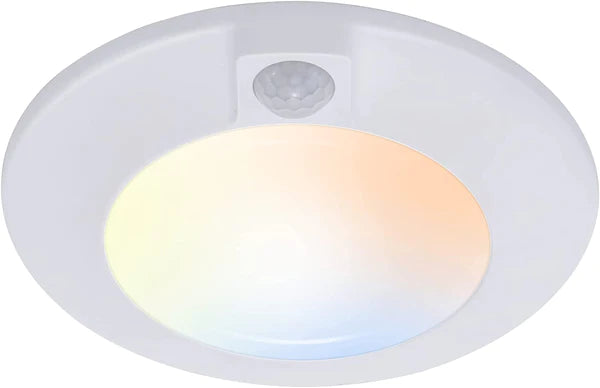In our modern lives, where convenience and energy efficiency are paramount, understanding how to manage these sensors is of great importance. Motion sensors in ceiling lights are designed to automatically turn the lights on and off based on detected movement. While this can be a convenient feature in some situations, there are times when it becomes necessary to disable it. Whether you want to enjoy a quiet evening without the lights flickering on and off or you're looking to control your lighting manually, knowing how to turn off the motion sensor is a valuable skill. In this blog post, we will delve into the intricacies of motion sensor ceiling lights, why you might want to turn them off, and how to do it effectively.
TABLE OF CONTENTS
- Understanding Motion Sensors in Ceiling Lights
- Reasons to Turn Off the Motion Sensor
- Step-by-Step Guide to Disabling the Motion Sensor
- Troubleshooting Common Issues
- Alternative Solutions and Considerations
- Conclusion

Understanding Motion Sensors in Ceiling Lights
-
Explanation of Motion Sensors:
Motion sensors, also known as occupancy sensors or PIR (Passive Infrared) sensors, are devices designed to detect movement within their field of view. They work by sensing changes in infrared radiation emitted by objects in their vicinity. In the context of ceiling lights, these sensors are integrated as a component within the light fixture. Typically, they are positioned in a way that allows them to monitor the area below. -
Benefits and Drawbacks:
Having a motion sensor in ceiling lights offers several advantages. Firstly, they enhance energy efficiency by ensuring that lights are only on when needed. This can lead to significant cost savings on electricity bills. Secondly, they provide convenience as they automatically illuminate spaces when someone enters, eliminating the need to fumble for a light switch. However, there are drawbacks as well. False activations can occur due to pets or even moving curtains, which can be irritating. Moreover, some users prefer manual control over their lighting and may find the automatic nature of motion sensors limiting. It's essential to weigh these pros and cons to decide if a motion sensor is suitable for your specific needs.
Reasons to Turn Off the Motion Sensor
-
Exploring Reasons:
There are several valid reasons why someone might want to disable the motion sensor feature in their ceiling lights. Firstly, privacy concerns can be a driving factor. Motion sensors detect movement, and some individuals may feel uncomfortable knowing that their movements are constantly monitored, even in the privacy of their own home. Secondly, aesthetics play a role. Some people prefer to have full control over their lighting design, and the automatic activation of lights may not align with their interior decor preferences. Lastly, in certain situations, such as during a movie night or when practicing relaxation exercises, the sudden illumination caused by motion detection can be disruptive. -
Inconvenient and Problematic Scenarios:
Motion sensors can sometimes become inconvenient or problematic. One common scenario is false triggers due to pets or even small insects, leading to unnecessary light activation. Additionally, if the sensor's sensitivity is too high, it might respond to distant movement outside the intended area, causing lights to turn on unnecessarily. This can be both irritating and wasteful. In some cases, motion sensors might not work well in dimly lit areas, causing delays in lighting activation, which can be frustrating. Understanding these scenarios helps individuals make informed decisions about whether to turn off the motion sensor.

Step-by-Step Guide to Disabling the Motion Sensor
Turning Off the Motion Sensor: Disabling the motion sensor in your ceiling lights is a straightforward process. Here's a step-by-step guide to help you do it:
- Step 1: Ensure the power to the ceiling light is switched off. This is crucial for your safety.
- Step 2: Carefully remove the cover or casing of the light fixture to access the internal components.
- Step 3: Locate the motion sensor module. It's usually a small device with wires connected to it.
- Step 4: Disconnect the wires from the motion sensor. You may need to use a screwdriver or pliers for this step.
- Step 5: Once the wires are disconnected, reattach the cover or casing of the light fixture.
- Step 6: Restore power to the ceiling light, and it will now function without the motion sensor.
Safety Precautions and Tools: When disabling the motion sensor, safety should be a top priority. Here are some precautions to keep in mind:
Troubleshooting Common Issues
Addressing Common Problems: While disabling the motion sensor is a relatively simple process, there are common issues that can arise during or after the procedure. Here are some problems you might encounter:
- Issue 1: Wires are tightly connected, making it challenging to disconnect them.
- Issue 2: The light fixture doesn't work even after reconnecting the wires.
- Issue 3: The motion sensor's LED light continues to blink.
Solutions and Tips: Here are solutions and tips for effective troubleshooting:
- Solution for Issue 1: If the wires are tightly connected, gently wiggle them while holding the connector to loosen the grip. Be careful not to damage the wires.
- Solution for Issue 2: If the light fixture doesn't work after reconnecting the wires, double-check the connections to ensure they are properly attached. Also, confirm that the power is restored.
- Solution for Issue 3: If the motion sensor's LED light continues to blink, it may indicate an issue with the sensor itself. You can read our "Why Are My LED Recessed Lights Flickering?"

Alternative Solutions and Considerations
Suggesting Alternative Methods: If you don't want to completely turn off the motion sensor but still wish to have more control, there are alternative methods to consider:
- Method 1: Adjust Sensitivity - Most motion sensors allow you to adjust sensitivity levels. Lowering the sensitivity can reduce false activations.
- Method 2: Use a Timer - Install a timer switch to control when the motion sensor operates. This way, you can set specific times for it to be active.
- Method 3: Cover the Sensor - If you only want to disable it temporarily, consider covering the sensor with opaque tape or a removable sticker.
Impact on Energy Savings and Security: It's essential to understand the implications of altering motion sensor settings:
- Energy Savings: Adjusting the sensor's settings or using a timer can still result in energy savings compared to leaving lights on continuously. However, completely disabling the sensor may lead to increased energy consumption.
- Security: While motion sensors can enhance security by illuminating areas when someone enters, altering the settings or turning them off entirely can impact this feature. It's crucial to strike a balance between energy savings and security to meet your specific needs.

Conclusion
In summary, managing motion sensor settings in ceiling lights involves finding the right balance between convenience, energy efficiency, and personal preferences. We discussed how to turn off the motion sensor, offered safety tips, and troubleshooting advice. If you prefer not to disable it entirely, you can adjust sensitivity or use timers as alternatives.
Consider the impact on energy savings and security when making changes. Lowering sensitivity or using timers can save energy, but turning off the sensor completely may increase energy consumption. Balancing these factors is crucial.




Share:
Is Track Lighting Outdated? Exploring Modern Lighting Solutions
How Far Apart Should Step Lights Be